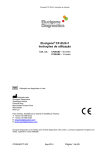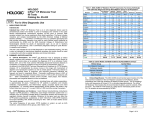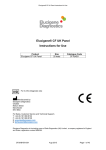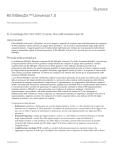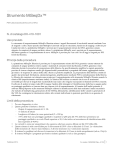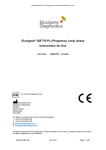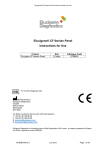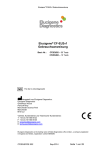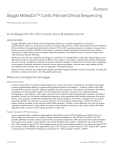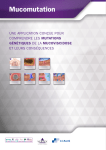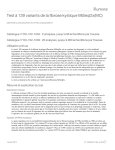Download GB - Elucigene
Transcript
Elucigene® CF-EU2v1 Instructions for Use Elucigene® CF-EU2v1 Instructions for Use Cat Code: CF2EUB2 – 50 tests CF2EUBX – 10 tests For In-Vitro Diagnostic Use Manufactured by: Elucigene Diagnostics Greenheys House Pencroft Way Manchester Science Park Manchester M15 6JJ For Sales, Customer Service and Technical Support:T: +44 (0) 161 669 8122 F: +44 (0) 161 669 8129 E: [email protected] E: [email protected] Elucigene Diagnostics is the trading name of Delta Diagnostics (UK) Limited., a company registered in England and Wales, registration number 8696299. CF2EUBYEN 002 Sep-2014 Page 1 of 24 Elucigene® CF-EU2v1 Instructions for Use Elucigene CF-EU2v1 Intended Use For the simultaneous in vitro qualitative detection of the following human Cystic Fibrosis Transmembrane conductance Regulator (CFTR) gene mutations in DNA extracted from whole blood (EDTA preserved) and dried bloodspot samples:- Traditional HGVS Nomenclature* cDNA name Protein name CFTRdele2,3 name c.54-5940_273+1025delProtein (c.54-5940_273+10250del21080) E60X c.178G>T p.Glu60X P67L c.200C>T p.Pro67Leu G85E c.254G>A p.Gly85Glu 394delTT c.262_263del (c.262_263delTT) p.Leu88IlefsX22 444delA c.313del (c.313delA) p.Ile105SerfsX2 R117C c.349C>T p.Arg117Cys R117H c.350G>A p.Arg117His Y122X c.366T>A p.Tyr122X 621+1G>T c.489+1G>T 711+1G>T c.579+1G>T L206W c.617T>G p.Leu206Trp 1078delT c.948del(c.948delT) p.Phe316LeufsX12 R334W c.1000C>T p.Arg334Trp R347P c.1040G>C p.Arg347Pro R347H c.1040G>A p.Arg347His A455E c.1364C>A p.Ala455Glu I507del c.1519_1521del (c.1519_1521delATC) p.Ile507del F508del c.1521_1523del (c.1521_1523delCTT) p.Phe508del 1677delTA c.1545_1546del (c.1545_1546delTA) p.Tyr515X V520F c.1558G>T p.Val 520Phe 1717-1G>A c.1585-1G>A G542X c.1624G>T p.Gly542X S549R(T>G) c.1647T>G p.Ser549Arg S549N c.1646G>A p.Ser549Asn G551D c.1652G>A p.Gly551Asp R553X c.1657C>T p.Arg553X R560T c.1679G>C p.Arg560Thr 1811+1.6kbA>G c.1680-886A>G 1898+1G>A c.1766+1G>A 2143delT c.2012del (c.2012delT) p.Leu671X 2184delA c.2052del (c.2052delA) p.Lys684AsnfsX38 2347delG c.2215del (c.2215delG) p.Val739TyrfsX16 W846X c.2538G>A p.Trp846X 2789+5G>A c.2657+5G>A Q890X c.2668C>T 3120+1G>A c.2988+1G>A CF2EUBYEN 002 p.Gln890X Sep-2014 Page 2 of 24 Elucigene® CF-EU2v1 Instructions for Use 3272-26A>G c. 3140-26A>G R1066C c.3196C>T p.Arg1066Cys Y1092X(C>A) c.3276C>A p.Tyr1092X M1101K c.3302T>A p.Met1101Lys D1152H c.3454G>C p.Asp1152His R1158X c.3472C>T p.Arg1158X R1162X c.3484C>T p.Arg1162X 3659delC c.3528del (c.3528delC) p.Lys1177SerfsX15 3849+10kbC>T c.3718-2477C>T S1251N c.3752G>A p.Ser1251Asn 3905insT c.3773dup (c.3773dupT) p.Leu1258PhefsX7 W1282X c.3846G>A p.Trp1282X N1303K c.3909C>G p.Asn1303Lys * with reference to – Mutation Nomenclature in Practice: Findings and Recommendations from the Cystic Fibrosis External Quality Assessment Scheme. Berwouts S, Morris M, Girodon G, Schwarz M, Stuhrmann M and Dequeker E. Human Mutation, Vol.00, No. 0, 1-7 (2011) CF-EU2v1 can distinguish between individuals who are heterozygous and homozygous for the all the above mutations and variants with the exception of S549R(T>G) – see cross reactivity section of this document. Summary and Explanation Cystic Fibrosis (CF) is the most common life-limiting autosomal recessive disorder in the Caucasian population. The disease incidence is 1:3200 live births among Caucasians(1). In the Caucasian population, the heterozygote frequency is approximately 1:25. Cystic fibrosis affects the epithelia in several organs resulting in a complex, multisystem disease that includes the exocrine pancreas, intestine, respiratory tract, male genital tract, hepatobiliary system, and exocrine sweat glands. Disease expression varies by severity of CFTR mutations (2), genetic modifiers (3), and environmental factors (4). The range extends from early childhood death as a result of progressive obstructive lung disease with bronchiectasis, to pancreatic insufficiency with gradually progressive obstructive lung disease during adolescence and increasing frequency of hospitalisation for pulmonary disease in early adulthood, to recurrent sinusitis and bronchitis or male infertility in young adulthood. Most commonly the diagnosis of cystic fibrosis is established in individuals with one or more characteristic phenotypic features of CF plus evidence of an abnormality in CFTR function based on one of the following: presence of two disease-causing mutations in the CFTR gene or two abnormal quantitative pilocarpine iontophoresis sweat chloride values (>60 mEq/L) or transepithelial nasal potential difference (NPD) measurements characteristic of CF. The CFTR mutation detection rate varies by test method and ethnic background. In some symptomatic individuals, only one or neither disease-causing mutation is detectable; in some carriers, the disease-causing mutation is not detectable. CFTR-related disorders are inherited in an autosomal recessive manner. Siblings of a proband with cystic fibrosis have a 25% chance of being affected, a 50% chance of being asymptomatic carriers, and a 25% chance of being unaffected and not carriers. Molecular genetic testing for diseasecausing mutation(s) in the CFTR gene is used for carrier detection in population screening programs. Prenatal testing is available for pregnancies at increased risk for CFTR-related disorders if the disease-causing mutations in the family are known. Since the discovery of the CFTR gene in 1989 (5), more than 1700 mutations and variants in the gene have been described (6). Many of these mutations are ‘private’, having been described only in one patient and/or family. Routine testing for all possible mutations is neither feasible nor cost effective and is therefore confined to testing for the most common mutations. CF-EU2v1 is a cystic fibrosis testing kit designed specifically to address the most common mutations found in populations CF2EUBYEN 002 Sep-2014 Page 3 of 24 Elucigene® CF-EU2v1 Instructions for Use of European origin. The assay identifies 50 mutations in total and also analyses the intron 9 polyT tract with accurate measurement of the adjacent TG repeat. The polymorphic thymidine tract at the junction of intron 9 and exon 10 influences transcription. The number of thymidine residues (5T, 7T or 9T) affects the splicing efficiency of exon 10; if the 5T allele is present a proportion of exon 10 transcripts will be absent resulting in non-functional protein and variable CF symptoms. It is reported that the number of TG repeats 5’ to the polythymidine tract can also influence splicing of exon 10 (7). If present on the same allele as the 5T variant the longer the number of TG repeats the higher the proportion of CFTR transcripts will lack exon 10. The number of TG repeats can be determined using CF-EU2v1 by sizing the 5T amplicon peaks. Principles of the Procedure The method employed by the Elucigene CF-EU2v1 kit uses fluorescent ARMS (Amplification Refractory Mutation System) allele specific amplification technology, which detects point mutations, insertions or deletions in DNA (8). The principle of ARMS is that oligonucleotides with a 3’ mismatched residue will not function as Polymerase Chain Reaction (PCR) primers under specified conditions. Selection of appropriate oligonucleotides allows specific mutant or normal DNA sequences to be amplified and detected. Amplified sequences (amplicons) are separated by capillary electrophoresis using an Applied Biosystems Genetic Analyzer instrument. Analysis software enables amplicons to be identified and labelled according to their size and dye colour. Elucigene CF-EU2v1 is a highly multiplexed assay comprising two (A and B) PCR reactions. Fifty mutant sequences within the CFTR gene are detected in the A mix and are visualised as blue amplicon peaks. Corresponding non-mutated normal (wild type) sequences are detected in the B mix and are visualised as green amplicon peaks. The A mix also detects normal sequence for the most commonly observed mutation causing cystic fibrosis in Caucasian populations, called F508del, and visualised as a green amplicon peak. Additionally polyT repeat sequences are detected in the A mix and visualised as black amplicon peaks. Internal amplification control markers (non cystic fibrosis) are included in both the A and B mixes to monitor the efficiency of sample amplification and are visualised as red amplicon peaks. CF2EUBYEN 002 Sep-2014 Page 4 of 24 Elucigene® CF-EU2v1 Instructions for Use Warnings and Precautions 1. The DNA Control supplied with this kit is of human origin and has been independently tested using a PCR based assay and found to be negative for Hepatitis B Virus (HBV), Hepatitis C Virus (HCV) and Human Immunodeficiency Virus 1 (HIV1). 2. Care should be taken when handling material of human origin. All samples should be considered potentially infectious. No test method can offer complete assurance that HBV, HCV, HIV 1 or other infectious agents are absent. 3. Handling of samples and test components, their use, storage and disposal should be in accordance with the procedures defined by the appropriate national biohazard safety guideline or regulation. 4. In line with current good laboratory practice, laboratories should process their own internal QC samples of known genotype in each assay, so that the validity of the procedure can be assessed. 5. If kit box is damaged, there maybe be damage to the contents, do not use the kit, contact Customer Service. CF2EUBYEN 002 Sep-2014 Page 5 of 24 Elucigene® CF-EU2v1 Instructions for Use Symbols Used on Labels The symbols used on all labels and packaging conform to the harmonised standard ISO 15223 Manufacturer Number of tests See Instructions for Use X° C Store below temperature shown Use before date shown Catalogue code Lot or batch number In Vitro Diagnostic Medical Device CF2EUBYEN 002 Sep-2014 Page 6 of 24 Elucigene® CF-EU2v1 Instructions for Use Materials Provided Storage of the reagents should be in an area free from contaminating DNA or PCR product. Store all components below -20°C in the dark. The fluorescent dyes used in this product are photosensitive, minimise exposure to light. Discard 3 months after opening. All reagents are supplied ready for use. Sufficient materials for 50 (10) tests are provided: 2 x 120µl (50µl) vials of CF-EU2v1 A primer mix, containing primers to amplify the following mutant alleles R347H, R347P, 2789+5G>A, 3120+1G>A, 711+1G>T, R334W, I507del, F508del, 3849+10kbC>T, 1677delTA, 1078delT, V520F, L206W, W1282X, R560T, 2347delG, Q890X, R553X, G551D, S549N, M1101K, G542X, 3905insT, Y1092X(C>A), S1251N, 444delA, 1811+1.6kbA>G, 1717-1G>A, R117H, R117C, N1303K, Y122X, 394delTT, G85E, R1066C, 1898+1G>A, W846X, 2184delA, D1152H, CFTRdele2,3, P67L, 2143delT, E60X, 3659delC, 3272-26A>G, 621+1G>T, A455E, R1162X and R1158X. This mix also contains wild type primers for the detection of normal F508del allele, primers for detection of the polythymidine variants, IVS8-5T, IVS8-7T, IVS8-9T and primers for identification of 2 hypervariable short tandem repeat (STR) markers – 404473 (450043). 2 x 120µl (50µl) vials of CF-EU2v1 B primer mix, containing wild type primers to amplify the normal alleles of the mutants amplified by the A primer mix with the exception of F508del, the normal allele, which is amplified by primers included in the A primer mix. This mix also contains primers for identification of 2 hypervariable STR markers – 404474 (450044). 2 x 400µl (75l) vials of PCR Master Mix containing HotStart Taq DNA Polymerase and deoxynucleotide triphosphates in buffer – 404480 (450045). 1 x 50µl vial DNA Control at 6ng/l, normal for the mutations detected by Elucigene CF-EU2v1 404489 Materials Required but not Provided Laboratory consumables – gloves; screw-capped microfuge tubes; 0.2ml PCR vials or microtitre plates recommended by the manufacturer of the thermal cycler used; pipette tips. DNA Preparation - QIAamp DNA Mini Kit (Qiagen GmbH, Cat No 51304/51306) or equivalent. Capillary Electrophoresis – GeneScan 600 LIZ size standard (ABI Cat No 4366589), GeneScan 600v2 LIZ size standard (ABI Cat No 4408399), Multi-capillary DS-33 (dye set G5) matrix standard (ABI Cat No 4345833), POP-7 Polymer (ABI Cat No 4352759), 10x Genetic Analyzer Buffer (ABI Cat No 402824) and Hi-Di Formamide (ABI Cat No 4311320). Note: Ensure that all materials used are within the manufacturer’s stability dating. Equipment Required Laboratory equipment – precision pipettes (2 sets: 1 for pre-amplification and 1 for post-amplification handling); protective clothing; vortex mixer; microfuge; 96 well microtitre plate centrifuge. PCR Amplification - Thermal cycler to accommodate 96 well microtitre plates or 0.2ml vials with a minimum temperature accuracy of +/-1°C between 33°C and 100°C and static temperature uniformity of +/-1°C. Note: Thermal cycler equipment should be regularly maintained, in accordance with the manufacturer’s instructions, and calibrated to ensure accurate PCR cycling and optimal performance. The Elucigene CF-EU2v1 assay was developed on Applied Biosystems 9700 thermal cyclers. Other makes and models should be fully tested and evaluated for optimal performance by the user before reporting results with CF-EU2v1. CF2EUBYEN 002 Sep-2014 Page 7 of 24 Elucigene® CF-EU2v1 Instructions for Use Capillary Electrophoresis - ABI 3130/3500 Genetic Analyzer (with GeneMapper fragment analysis software), 36cm or 50cm (ABI3500) capillary array, 96 well optical plates, 96 well septas, 96 well cassettes. Note: Capillary electrophoresis equipment should be regularly maintained in accordance with the manufacturer’s instructions and calibrated to ensure optimal performance. Sample Collection and Storage Whole blood (EDTA) samples and dried bloodspots have been evaluated to be compatible with this test. Sample collection devices have on occasion been reported to be detrimental to the integrity of certain analytes and could interfere with some method technologies (9). It is recommended that each user ensure that the chosen device is used according to the manufacturer’s instructions and sample collection devices are compatible with this test. Blood samples should be stored at -20°C prior to preparation of DNA. Avoid repeated freezing and thawing. Preparation of DNA from Whole Blood (EDTA) Samples Results are consistently obtained with DNA extracted using the QIAamp 96 DNA Blood Kit (or the QIAamp DNA Mini Kit using Proteinase K) following the protocol as described in the QIAamp Handbook starting with 200l liquid whole blood and eluting in 200l of molecular biology grade water. Preparation of DNA from Dried Bloodspots Results are consistently obtained with DNA extracted using the QIAamp DNA Mini Kit following the protocol as described in the QIAamp Handbook but starting with 2 x 3mm discs from a dried blood spot and eluting in 100l of molecular biology grade water. It is recommended that alternative DNA extraction methods and sample types are thoroughly evaluated with the Elucigene CF-EU2v1 test prior to the results being used for diagnostic purposes. Important Considerations - DNA Amount Under optimal PCR conditions and using the recommended sample injection settings (see note in Capillary Electrophoresis section) given in the capillary column run modules, acceptable results have been routinely obtained from DNA extracted using the above methods at concentrations between 1.5ng/l and 25ng/l. The quantification of DNA is very important, the concentration of every DNA sample to be tested should be measured to ensure optimal results. Techniques such as PicoGreen fluorescence or UV absorbance are acceptable. Due to variation in DNA quantification techniques the user should consider the following guidance: Very high input DNA amounts will increase the likelihood that background peaks are labelled by the analysis software. The following steps can be taken to reduce the likelihood that background peaks are labelled. Dilute DNA sample and re-amplify Reduce injection time – see Capillary Electrophoresis section Increase minimum peak amplitude threshold – see Elucigene CF-EU2v1 Guide to Analysis Software Low input DNA amounts will increase the likelihood that diagnostic peaks are weak and not labelled by the analysis software. The following steps can be taken to increase signal. Increase injection time to 36 seconds (strongly recommended for bloodspot extractions) see Capillary Electrophoresis section Re-extract bloodspot sample and elute in reduced volume (50l) of water Increase number of bloodspots for extraction to 4 x 3mm discs CF2EUBYEN 002 Sep-2014 Page 8 of 24 Elucigene® CF-EU2v1 Instructions for Use Important Considerations - DNA Quality CF-EU2v1 is a highly multiplexed assay and requires efficient PCR amplification to function optimally. Quality of DNA can determine the efficiency of the PCR process. Inhibitors co-extracted with the DNA sample may result in a sub-optimal amplification leading to weak and poorly balanced peaks. Elucigene Diagnostics has validated the use of QIAamp 96 DNA Blood Kit and QIAamp DNA Mini Kit (QIAGEN GmbH) with the CF-EU2v1 kit. Other DNA extraction kits or methods should be validated and optimised for use with CF-EU2v1. Note: See Elucigene CF-EU2v1 Troubleshooting Guide for more information. CF2EUBYEN 002 Sep-2014 Page 9 of 24 Elucigene® CF-EU2v1 Instructions for Use Test Protocol Control of PCR contamination The PCR process generates a large number of amplified products (amplicons) and carries a high risk of contamination which may lead to false results. Contamination can arise from two sources: Cross contamination – contamination of the sample with non-amplified material from the environment, or other samples which contain the target sequence. End product contamination – contamination of the sample with amplicons from previous PCR’s leading to amplification of both target and contaminant amplicons. Laboratories performing PCR should be aware of these sources of contamination and have procedures in place that significantly reduce the risk of contamination. Methods to control contamination are well documented (10) and include the physical design of laboratories, workflow, sample handling procedures and chemical and enzymatic approaches. Well defined and good laboratory procedures are essential to control PCR contamination and should be implemented prior to testing clinical samples. Amplification Procedure Note: To minimise the risk of contamination, steps 3 - 5 must be carried out in an area free from PCR product, preferably in a laminar flow cabinet. 1. Program the thermal cycler for a single step cycle to activate the HotStart Taq at 94°C for 20 minutes linked to an amplification cycling program of 1 minute at 94°C (denaturation), 2 minutes at 58°C (annealing) and 1 minute at 72°C (extension) for 30 cycles. This should be linked to a 20 minutes time-delay file at 72°C (extension) on the final cycle. 2. A negative control must be included in each PCR run. 3. Thaw the Primer Mixes and the PCR Master Mix and centrifuge briefly to collect the contents at the bottom of the vials. Mix gently by vortexing and briefly centrifuge the vials again. Prepare sufficient Reaction Mix for the number of samples and controls to be tested (Table 1). Note: The PCR Master Mix is viscous and care should be taken to ensure that the correct volumes are handled. It is recommended that the PCR Master Mix be added to the previously dispensed primer mixes to ensure all liquid is dispensed from the pipette into the Primer Mix. Note: Do not use different mixes or components from different lots of CF-EU2v1 kit. Cycling Enzyme Activation 94 oC 94 oC 20 min. 1 min. Final Extension 72 oC 72 oC 1 min. 20 min. 58 oC Ambient Temperature 2 min. 30 Cycles CF2EUBYEN 002 Sep-2014 Page 10 of 24 Elucigene® CF-EU2v1 Instructions for Use Table 1: Reaction Mix Formulation Primer Mix (μl) PCR Master Mix (μl) Total (μl) Number of Samples to be Tested 1 10 25 50 4.5 45 112.5 225 7.5 75 187.5 375 12 120 300 600 4. Pipette 10μl of each reaction mix into the bottom of the appropriately labelled 0.2ml PCR vials or plates. 5. Using separate pipette tips add 2.5μl of test DNA sample to each of the vials and cap. Do not add DNA to the vial for the negative control, substitute with 2.5µl of sterile deionised water. 6. Centrifuge the PCR vials briefly to collect the contents at the bottom of the vials. 7. Place the vials firmly in the thermal cycler block. Initiate the 94°C single step cycle followed by the amplification cycling program. 8. On completion of the amplification cycling program, the samples may be stored at room temperature overnight or at 2-8°C for up to 7 days in the dark before analysis by capillary electrophoresis. Capillary Electrophoresis It is recommended that each user ensure that the chosen capillary electrophoresis equipment is used according to the manufacturer’s instructions and is compatible with this test. In this context the key parameters are the polymer and the capillary array. Optimal results can be obtained using the following capillary electrophoresis conditions: 1. Combine 6.8μl of GS600v2 LIZ size standard with 250μl Hi-Di Formamide and mix thoroughly (sufficient mix for 16 wells). Dispense 15μl of the mix into each well of a 96 well PCR plate. 2. Add 3µl of PCR product from each of the A and B mix amplifications to separate wells containing the size standard/formamide mix (from step 1) already dispensed into the plate. 3. Denature the PCR product dispensed into the PCR plate on a thermal cycler using the following parameters: 94°C for 3 minutes linked to 4°C for 30 seconds. 4. Centrifuge the plate briefly to collect the contents at the bottom of the vials and to remove any bubbles in the wells and immediately load onto the Genetic Analyzer. Note: Sample injection settings can be modified to suit the amount of amplicon produced during the PCR which can vary due to amount of input genomic DNA added. Less amplicon can be applied to the column for analysis by reducing either time or voltage of injection. Conversely more amplicon can be applied to the column for analysis by increasing either time or voltage of injection. Previously amplified samples can be re-injected multiple times for re-analysis – see Elucigene CF-EU2v1 Troubleshooting Guide for more information. CF2EUBYEN 002 Sep-2014 Page 11 of 24 Elucigene® CF-EU2v1 Instructions for Use ABI 3130 Instruments: A CF-EU2 run module and protocol need to be created which can then be used for each CF-EU2 run. Create the CF-EU2 run module in the Module Manager of the 3130 data collection software. Ensure the following are selected: • Type: Regular • Template: FragmentAnalysis36_POP7 • Enter the settings detailed in the table below: 36cm Capillary Module # Parameter Name 1 2 3 4 5 6 7 8 9 10 11 12 Oven Temperature Poly_Fill_Vol. Current Stability PreRun_Voltage Pre_Run_Time Injection_Voltage Injection_Time Voltage_Number_Of_Steps Voltage_Step_Interval Data_Delay_Time Run_Voltage Run_Time Value 60 6500 5.0 15.0 180 3.0 12.0** 20 15 60 15.0 1200 Range int 18…65 Deg.C 6500…38000 steps int 0…2000 uAmps 0…15 kvolts 1…1000 sec. 1…15 kvolts 1…600 sec. 1…100 nk 1…60 sec. 1…3600sec. 0…15 kvolts 300…14000 sec. ** Increase injection time to 36 seconds for analysis of DNA extracted from bloodspots Note: Required ‘run time’ will vary dependent on the ambient temperature of the location in which the Genetic Analyzer has been installed. For more information on creating run modules please refer to the Applied Biosystems 3130 Genetic Analyzer User Manual. Create the CF-EU2 protocol in the Protocol Manager, ensure the following are selected: • Type: Regular • Run Module: CF-EU2 (see run module above) • Dye Set: G5 To run the samples create a sample sheet using the Plate Manager, ensure the correct protocol for CF-EU2v1 has been selected for the instrument protocol (see above). Note:For more information on instrument setup, operation and troubleshooting please refer to the Applied Biosystems 3130 Genetic Analyzer User Manual. CF2EUBYEN 002 Sep-2014 Page 12 of 24 Elucigene® CF-EU2v1 Instructions for Use ABI 3500 Instruments: A CF-EU2 Instrument Protocol needs to be created which can then be used for each CF-EU2v1 run. Create the CF-EU2 Instrument Protocol through the 3500 Instrument Protocols library. Ensure the following are selected: • Run Module: FragmentAnalysis50_POP7 • Enter the settings detailed in the image below: ** ** Increase injection time to 36 seconds for analysis of DNA extracted from bloodspots To run the samples create a sample plate by clicking on ‘Create Plate from Template’ in the ‘Dashboard’, ensure the correct Instrument Protocol for CF-EU2v1 has been assigned (see above). Sample sheet set-up for GeneMarker: The GeneMarker software allows the direct comparison between the A and B data from the same individual. To facilitate this it is important that the naming of the raw data output file (fsa) file is consistent across all samples and mixes. The sample sheet should contain the unique sample name for each sample being tested suffixed by either _A or _B depending which mix is being tested. If the Plate ID is to be included in the fsa name then a fixed format should be used each time e.g. CFEU2 DDMMYYYY. On the 3130 the “Results Destination” parameters should be set so that the sample name is included in the fsa file name e.g. CFEU2 DDMMYYYY_1234,5_A_A01. CF2EUBYEN 002 Sep-2014 Page 13 of 24 Elucigene® CF-EU2v1 Instructions for Use On the 3500 the file name convention should be set so that the sample name is included in the fsa file name e.g. CFEU2 DDMMYYYY_1234,5_A_A01. Interpretation of Results During data collection, PCR fragments will be observed as either Blue (mutant) or Green (wild type) peaks on the Raw Data electropherogram. An individual has two copies of the CFTR gene. Where these copies have the same sequence for any given site, an individual is described as being homozygous for this site. Where the copies differ in sequence at a given site, an individual is described as being heterozygous for this site. Once data collection has finished, CF-EU2v1 PCR fragments should be sized against the GS600v2 LIZ size standard using fragment analysis software. The Elucigene CF-EU2v1 Guide to Analysis Software document provides further detailed guidelines for software settings, analysis and interpretation. Guide to Analysis Software procedures are available for GeneMapper and GeneMarker software from the Elucigene website: www.elucigene.com/products CF2EUBYEN 002 Sep-2014 Page 14 of 24 Elucigene® CF-EU2v1 Instructions for Use The results from the A (mutant) mix determines if an individual carries a mutation and is shown by the presence of a blue peak. The mutant mix also contains primers for the normal F508 allele, therefore this mix can determine if an individual is normal for F508 (green peak only), homozygous for the mutant F508del (blue peak only) or heterozygous for F508del (blue and green peak). If any other mutation is observed the results from the B (wild type) mix can be analysed to determine homozygous or heterozygous status. The presence of a green peak for the particular allele in the wild type mix indicates the individual is heterozygous and the absence of the green peak indicates the individual is homozygous for the particular mutation. Hypervariable STR markers (red) are included in both mixes. This enables the comparison between the sample amplified with the mutant mix and the sample amplified with the wild type mix to reduce the potential for sample mix up; a different STR profile in each of the two mixes indicates a sample mix up. Absence of these STR markers indicates a failed sample. Presence of the STR markers at very low rfus indicates a weak sample which should be analysed with caution. Note: See Troubleshooting Guide for more information. CF2EUBYEN 002 Sep-2014 Page 15 of 24 Elucigene® CF-EU2v1 Instructions for Use Markers Detected The table below summarises the markers detected by CF-EU2v1 mix. Markers are listed according to the size range of PCR product observed. Markers Detected Marker (Peak No.) 01 02 03 04 05 06 07 08 09 10 11 12 13 14 15 16 17 18 19 20 21 22 23 24 25 26 27 28 29 30 31 32 33 34 35 36 37 38 39 40 41 42 43 44 45 46 47 CF2EUBYEN 002 Marker R347H R347P 2789+5G>A 3120+1G>A 711+1G>T R334W I507del F508del 3849+10KbC>T 1677delTA 1078delT V520F L206W W1282X R560T 2347delG Q890X R553X G551D S549R(T>G)* S549N M1101K G542X 3905insT Y1092X(C>A) S1251N 444delA 1811+1.6kbA>G 1717-1G>A R117H R117C N1303K Y122X 394delTT G85E R1066C 1898+1G>A W846X 2184delA D1152H CFTRdel2,3 P67L 2143delT E60X 3659delC 3272-26A>G 621+1G>T Sep-2014 Product bp Size Range (3130/POP7 data) 110.5-116.5 117-123 124-130 132.5-138.5 141.5-147.5 147.5-154 156-162.5 163-169 172-178 180-188.5 193-199 206-211.5 215-220 224.5-230.5 234.5-240.5 242-246 250-252 255.5-261.5 265-267 267.5-269.5 275-280 282-288 289-295.5 297-303.5 308-314 315-321 323-326 332-338 341.5-347.5 349-355 357-360 360-366.5 367-373 377-383 384-390 391-397 398.5-404.5 406-411 413-418 423-429 433-439 439.5-445.5 446-450.5 453.5-460.5 461-465.5 470-476 485.5-491.5 Page 16 of 24 Elucigene® CF-EU2v1 Instructions for Use Marker # 48 49 50 5T** 7T 9T Marker A455E R1162X R1158X IVS8-5T IVS8-7T IVS8-9T Product bp Size Range (3130/POP7 data) 496-503 506-512 516.5-524.5 110-130 140-160 175-195 *S549R(T>G) Peak 20 is only present in the A mix. ** 5T Allele sizes Marker 5T (9) 5T (10) 5T (11) 5T (12) 5T (13) Product bp Size Range (3130/POP7 data) 117.25 – 118.75 119.25 – 120.75 121.25 – 122.75 123.25 – 124.75 125.25 – 126.75 NOTE: Marker sizes may vary due to the instrument and polymer used. Examples of Interpretation I507del Due to the location of the I507del deletion in the CFTR gene it is possible to detect the presence of this marker through a 3bp shift in size of the F508del peak as well as an I507del mutant specific peak. Where a single I507del mutant allele is present the I507del mutant peak will be observed as a blue peak at approximately 159bp. A wild type peak for F508 will be observed as being present, but at approximately half the peak height normally associated with a homozygous wild type genotype; this is seen as a green peak at about 167bp. There will also be an additional green peak observed at about 164bp. I507del heterozygote sample An I507del/F508del sample will yield a shifted green F508del WT peak at approximately 164bp (3bp less than normal), a blue F508del M peak at 166bp and a blue I507del M peak at about 159bp. An I507del/I507del sample will yield a blue peak at approximately 159bp and a single green peak at approximately 164bp (3bp smaller than the normal F508 peak observed when I507del is not present. CF2EUBYEN 002 Sep-2014 Page 17 of 24 Elucigene® CF-EU2v1 Instructions for Use F508del The presence of an F508del mutation prevents the I507del WT primer working. Therefore, an individual homozygous for F508del will have no I507del WT peak in the WT mix (see below). A reduced height I507del WT peak and 2 peaks 3bp apart at positions 10 and 12 in the WT mix (see below) will be observed in the B mix results from an individual heterozygous for F508del. Insertions and Deletions Due to the nature of the design of the CF-EU2v1 kit the presence of insertions or deletions between two opposing primers will result in size changes to all the amplicon produced between these two primers. Therefore in addition to the 50 mutations detected by the CF-EU2v1 kit, any insertions and deletions within the amplified target sequences can be detected by the change in expected amplicon size in the wild type (B) mix. These have been tabulated and are available in a separate document from the Elucigene website: www.elucigene.com/products Examples of insertions and deletions detected by the kit and impact they have on the B mix profile are shown below: F508del/1677delTA Two peaks 1bp apart at position 12 (V520F WT) will be observed in the B mix results from an individual heterozygous for the F508del/1677delTA mutations. CF2EUBYEN 002 Sep-2014 Page 18 of 24 Elucigene® CF-EU2v1 Instructions for Use V520F A wild type peak of reduced height at position 10 (1677delTA WT) will be observed in the B mix results from an individual heterozygous for the V520F mutation as this prevents the 1677delTA WT primer working. Peaks 10 & 12 will drop out in the results from an individual homozygous for the V520F mutation. 394delTT Two peaks 2bp apart at positions 35 (G85E WT), 42 (P67L WT) & 44 (E60X WT) will be observed in the B mix results from an individual heterozygous for the 394delTT mutation. Peak 34 will drop out and peaks 35, 42 & 44 will be the expected height but shifted 2bp smaller than expected size in the results from an individual homozygous for the 394delTT mutation. F508del/CFTRdele2,3 Reduced peak heights at positions 34 (394delTT), 35 (G85E WT), 41 (CFTRdele2,3 WT), 42 (P67L WT) & 44 (E60X WT) will be observed in the B mix results from an individual heterozygous for the CFTRdele2,3 mutation. Peaks 34, 35, 41, 42 & 44 will drop out in results from an individual homozygous for the CFTRdele2,3 mutation. CF2EUBYEN 002 Sep-2014 Page 19 of 24 Elucigene® CF-EU2v1 Instructions for Use 444delA Two peaks 1bp apart at positions 30 (R117H WT), 31 (R117C WT), 33 (Y122X WT) & 47 (621+1 WT) will be observed in the B mix results from an individual heterozygous for the 444delA mutation. Peak 27 will drop out and peaks 30, 31, 33 & 47 will be the expected height but shifted 1bp smaller than expected size in the results from an individual homozygous for the 444delA mutation. 2347delG Two peaks 1bp apart at positions 39 (2184delA WT) & 43 (2143delT WT) will be observed in the B mix results from an individual heterozygous for the 2347delG mutation. Peak 16 will drop out and peaks 39 & 43 will be the expected height but shifted 1bp smaller than expected size in the results from an individual homozygous for the 2347delG mutation. 3905insT Two peaks 1bp apart at position 26 (S1251N WT) will be observed in the B mix results from an individual heterozygous for the 3905insT mutation. Peak 24 will drop out and peak 26 will be the expected height but shifted 1bp larger than the expected size in the results from an individual homozygous for the 3905insT mutation. CF2EUBYEN 002 Sep-2014 Page 20 of 24 Elucigene® CF-EU2v1 Instructions for Use R1158X Reduced peak height at position 49 (R1162X WT) will be observed in the B mix results from an individual heterozygous for the R1158X mutation. Peak 49 will drop out in results from an individual homozygous for the R1158X mutation. Polymorphism rs4148721 (delAT) in Intron 22 Two peaks 2bp apart at positions 45 (3659delC WT), 49 (R1162X WT) & 50 (R1158X WT) will be observed in the B mix results from an individual heterozygous for the polymorphism rs4148721 (deletion of AT) in intron 22. Peaks 45, 49 & 50 will be the expected height but shifted 2bp smaller than expected size in the results from an individual homozygous for the polymorphism rs4148721. Other Observations V520F - Polymorhism 1584G>A in exon 12 The 1584G>A polymorphism has been identified to interfere with amplification of the V520F mutant and wild type sequence. Reduced peak height at position 12 (V520F) will be observed in the B mix in an individual heterozygous for the 1584G>A polymorphism. Peak 12 will drop out of the B mix in an individual homozygous for the1584G>A polymorphism. An individual who is heterozygous for the F508del mutation and also heterozygous for the 1584G>A mutation will exhibit only one peak 12 in the B mix rather than the expected two peaks at position 12 normally seen in a F508del heterozygote – see example below. Peak 12 will drop out of the A mix in an individual heterozygous for the V520F mutation and the 1584G>A polymorphism on the same allele, such a result has not been observed to date and is likely to be a rare combination. CF2EUBYEN 002 Sep-2014 Page 21 of 24 Elucigene® CF-EU2v1 Instructions for Use Cross Reactivity Every effort has been taken during test development to avoid interference of test function by the presence of other reported polymorphisms and mutations in the CFTR gene. The rare mutation R1283M has been evaluated for cross reactivity and was not detected by the Elucigene CF-EU2v1 kit. In addition the following polymorphisms were not detected by the test: 1655T/G (F508C), 1651A/G. Evaluation of known mutations and polymorphisms in the CFTR gene has highlighted the following effects on the Elucigene CF-EU2v1 kit results: 1. The G551D mutant primer in the A mix will also detect the S549RT>G mutation. The analysis software will label this as peak 20. There will not be a corresponding wild type peak in the B mix. 2. The 2184delA mutant primer in the A mix will cross react with 2183AA>G mutant DNA sequence and result in a mutant peak at the 2184delA position. 3. The 1078delT mutant primer in the A mix will cross react with F316L mutant DNA sequence and result in a mutant peak at the 1078delT position. 4. The R347P mutant primer in the A mix will cross react with R347H mutant DNA sequence and result in a mutant peak at the R347P position of reduced height compared to a true R347P peak. 5. The presence of the F508C (1655T>G) polymorphism will result in the reduction of the height of the I507del peak in the CF-EU2v1 B mix. 6. The presence of the R117H will result in the reduction of the height of the R117C peak in the CFEU2v1 B mix. In a sample homozygous for R117H the R117C peak will be absent. 7. The presence of the G85E will result in the reduction of the height of the 394delTT peak in the CF-EU2v1 B mix. In a sample homozygous for G85E the 394delTT peak will be absent. 8. A very small artefact peak in the I507del position can sometimes be observed in the results from an F508del heterozygote and in particular an F508del homozygote sample. 9. The following mutations, which have not been checked for possible cross reactivity due to unavailability of relevant samples, may interfere with test function: R117P, R117L, 1717-2A>G, 621+2T>C, 621+2T>G, R553G, R553Q, R347L, I506T, I506S, I506V and the rare combination of I507del with the polymorphism 1651A/G. Performance Characteristics One hundred and ten DNA samples extracted from liquid whole blood (EDTA) were tested blind using Elucigene CF-EU2v1. Five samples failed after PCR which correlated to low DNA concentration (less than 1.5ng/μl). Of those that gave interpretable results 96 were normal, 5 were heterozygous for F508del, 1 was heterozygous for 1717-1G>A, 1 was heterozygous for G551D, 1 was heterozygous for 621+1G>T, 1 was heterozygous for G542X and 1 was compound heterozygous for G542X/F508del. Ninety one DNA samples extracted from dried bloodspots were tested blind using Elucigene CFEU2v1. Five samples failed to amplify. Of those samples that did amplify 20 failed to meet analysis criteria for interpretation following a 12 second injection onto a 3500 Genetic Analyzer, all failed samples correlated to low concentration DNA (less than 1.5ng/μl). The 20 failed samples were reinjected for 36 seconds on the 3500 Genetic Analyzer and analysed, 7 samples failed to meet analysis criteria for interpretation. Of the 79 samples that gave interpretable results 38 were normal, 5 were heterozygous for F508del, 3 were heterozygous for G551D, 3 were heterozygous for W1282X, 2 were heterozygous for D1152H and 2 were heterozygous for G542X. Four compound heterozygotes, 3120+1G>A/F508del, R117H/F508del, R1162X/F508del and R553X/F508del were also determined. Additionally the following heterozygous samples were each observed on a single occasion, E60X, G85E, 394delTT, Y122X, 621+1G>T, 1078delT, R334W, R347P, A455E, I507del, 1717-1G>A, R553X, 1811+1.6kbA>G, 1898+1G>A, 2184delA, W846X, 3272-26A>G, Y1092X, 3659delC, 3849+10kbC>T, S1251N and N1303K. Forty six DNA samples representing all 50 mutations detected by the CF-EU2v1 kit were amplified on five separate occasions. All samples gave the expected results with no false negative or false positive results, demonstrating 100% clinical specificity and sensitivity. CF2EUBYEN 002 Sep-2014 Page 22 of 24 Elucigene® CF-EU2v1 Instructions for Use Troubleshooting These Instructions for Use are supplied to ensure optimal performance of the assay. Users must not deviate from the procedures provided. Any deviation may result in sub-optimal performance yielding poor quality data. A Troubleshooting Guide is available on request from Elucigene Diagnostics and provides examples and solutions to some of the most common observations with Elucigene CFEU2v1, these include: No Diagnostic or STR Peaks Weak Diagnostic or STR Peaks Excessive Breakthrough/Background Peaks Unlabelled Peaks Weak FAM (Mutant) Peaks Unbalanced A Mix Profile Unbalanced B Mix Profile Split Peaks in B Mix Profile To obtain a copy of the Elucigene CF-EU2v1 Troubleshooting Guide please contact our Technical Support Group: T: +44 (0) 161 669 8122 F: +44 (0) 161 669 8129 E: [email protected] E: [email protected] Limitations of the Procedure 1. The results obtained from this or any other diagnostic test should be used and interpreted only in the context of the overall clinical picture. Elucigene Diagnostics is not responsible for any clinical decisions that are taken. 2. The absence of the mutations detected by this kit is no guarantee that other mutations in the CFTR gene are not present. Other mutations are possible and are not detected by this kit. 3. Mutations vary in frequency between different populations. Population mutation frequency data is available from The Cystic Fibrosis Genetic Analysis Consortium (6). The user of this kit should emphasise these points when reporting results to the diagnosing Clinician/Genetic Counsellor. Disclaimer Results from this and other diagnostic assays should be interpreted in conjunction with other laboratory and clinical data available to the Clinician. These Elucigene reagents are supplied for In Vitro diagnostic testing. Further details for data interpretation are available in the Elucigene CF-EU2v1 Guide to Analysis Software procedures: www.elucigene.com/products CF2EUBYEN 002 Sep-2014 Page 23 of 24 Elucigene® CF-EU2v1 Instructions for Use References 1. Rosenstein BJ, Cutting GR. The diagnosis of cystic fibrosis: a consensus statement. Cystic Fibrosis Foundation Consensus Panel. J Pediatr. 1998;132:589–95. 2. De Braekeleer M, Allard C, Leblanc JP, Simard F, Aubin G. Genotype-phenotype correlation in cystic fibrosis patients compound heterozygous for the A455E mutation. Hum Genet. 1997;101:208–11 3. Drumm ML, Konstan MW, Schluchter MD, Handler A, Pace R, Zou F, Zariwala M, Fargo D, Xu A, Dunn JM, Darrah RJ, Dorfman R, Sandford AJ, Corey M, Zielenski J, Durie P, Goddard K, Yankaskas JR, Wright FA, Knowles MR. Genetic modifiers of lung disease in cystic fibrosis. N Engl J Med. 2005;353:1443–53 4. Goss CH, Newsom SA, Schildcrout JS, Sheppard L, Kaufman JD. Effect of ambient air pollution on pulmonary exacerbations and lung function in cystic fibrosis. Am J Respir Crit Care Med. 2004;169:816–21 5. Kerem B, Rommens JM, Buchanan JA, Markiewicz D, Cox TK, Chakravarti A, Buchwald M, and Tsui LC. "Identification of the Cystic Fibrosis Gene: Genetic Analysis." Science 1989; 245 (4922): 1073-8 6. Cystic Fibrosis Mutation Database, www.genet.sickkids.on.ca/cftr/app 7. Joshua D. Groman et al. Variation in a Repeat Sequence Determines Whether a Common Variant of the Cystic Fibrosis Transmembrane Conductance Regulator Gene Is Pathogenic or Benign. Am J Hum Genet. 2004; 74(1): 176–179. 8. Newton CR et al. Analysis of any point mutation in DNA. The Amplification Refractory Mutation System (ARMS). Nucleic Acid Res 17: 2503-2516 (1989). 9. Satsangi J et al. Effect of heparin on polymerase chain reaction. Lancet 343:1509-1510 (1994). 10. PCR Primer: A Laboratory Manual, 2nd edition. ColdSpring Harbour Laboratory Press: Section 1 ELUCIGENE is a trademark of Delta Diagnostics (UK) Ltd. ARMS is a trademark of AstraZeneca UK, QIAAMP is a trademark of Qiagen Gmbh. PICOGREEN is a trademark of Molecular Probes Inc. GENEMARKER is a trademark of Softgenetics Corporation. GENEMAPPER, NED, VIC, PET, POP-7, LIZ and HI-DI are trademarks of Life Technologies Corporation. NOTICE TO PURCHASER: LIMITED LICENCE Polynucleotides labeled with VIC, NED and PET dyes and/or their use may be covered by one or more patents owned by Life Technologies Corp. The purchase price of this product includes limited, nontransferable rights under certain claims of certain patents owned by Life Technologies Corp. to use only this amount of the product solely for activities of the purchaser in detection of Target(s) within the field of human diagnostics. No other rights are conveyed. Further information on purchasing licenses relating to the dyes mentioned above may be obtained by contacting the Director of Licensing, [email protected]. Copyright 2014 Delta Diagnostics (UK) Ltd. CF2EUBYEN 002 Sep-2014 Page 24 of 24
























